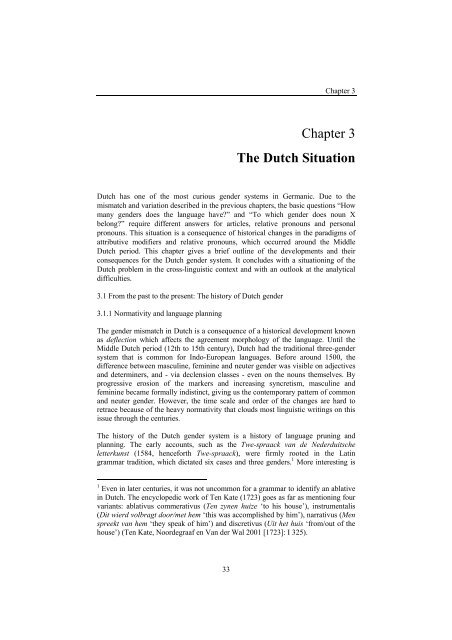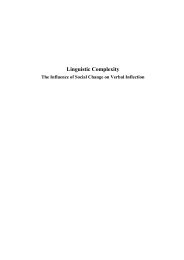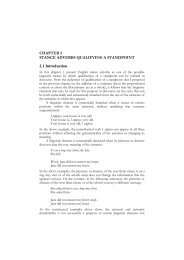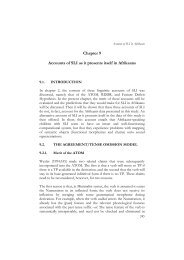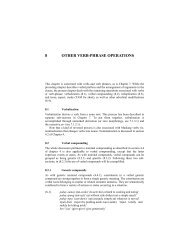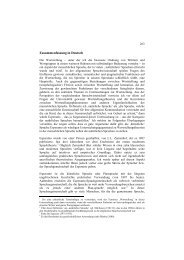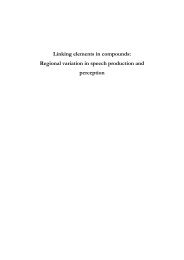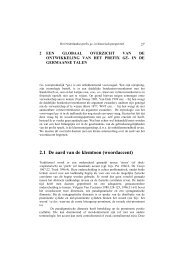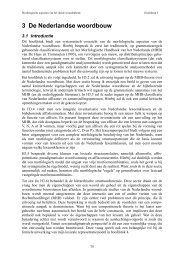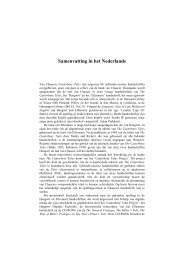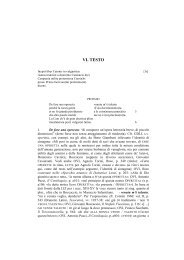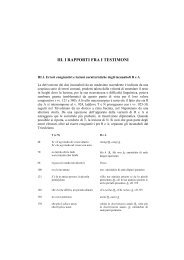Chapter 3 The Dutch Situation - LOT publications
Chapter 3 The Dutch Situation - LOT publications
Chapter 3 The Dutch Situation - LOT publications
You also want an ePaper? Increase the reach of your titles
YUMPU automatically turns print PDFs into web optimized ePapers that Google loves.
33<br />
<strong>Chapter</strong> 3<br />
<strong>Chapter</strong> 3<br />
<strong>The</strong> <strong>Dutch</strong> <strong>Situation</strong><br />
<strong>Dutch</strong> has one of the most curious gender systems in Germanic. Due to the<br />
mismatch and variation described in the previous chapters, the basic questions “How<br />
many genders does the language have?” and “To which gender does noun X<br />
belong?” require different answers for articles, relative pronouns and personal<br />
pronouns. This situation is a consequence of historical changes in the paradigms of<br />
attributive modifiers and relative pronouns, which occurred around the Middle<br />
<strong>Dutch</strong> period. This chapter gives a brief outline of the developments and their<br />
consequences for the <strong>Dutch</strong> gender system. It concludes with a situationing of the<br />
<strong>Dutch</strong> problem in the cross-linguistic context and with an outlook at the analytical<br />
difficulties.<br />
3.1 From the past to the present: <strong>The</strong> history of <strong>Dutch</strong> gender<br />
3.1.1 Normativity and language planning<br />
<strong>The</strong> gender mismatch in <strong>Dutch</strong> is a consequence of a historical development known<br />
as deflection which affects the agreement morphology of the language. Until the<br />
Middle <strong>Dutch</strong> period (12th to 15th century), <strong>Dutch</strong> had the traditional three-gender<br />
system that is common for Indo-European languages. Before around 1500, the<br />
difference between masculine, feminine and neuter gender was visible on adjectives<br />
and determiners, and - via declension classes - even on the nouns themselves. By<br />
progressive erosion of the markers and increasing syncretism, masculine and<br />
feminine became formally indistinct, giving us the contemporary pattern of common<br />
and neuter gender. However, the time scale and order of the changes are hard to<br />
retrace because of the heavy normativity that clouds most linguistic writings on this<br />
issue through the centuries.<br />
<strong>The</strong> history of the <strong>Dutch</strong> gender system is a history of language pruning and<br />
planning. <strong>The</strong> early accounts, such as the Twe-spraack van de Nederduitsche<br />
letterkunst (1584, henceforth Twe-spraack), were firmly rooted in the Latin<br />
grammar tradition, which dictated six cases and three genders. 1 More interesting is<br />
1 Even in later centuries, it was not uncommon for a grammar to identify an ablative<br />
in <strong>Dutch</strong>. <strong>The</strong> encyclopedic work of Ten Kate (1723) goes as far as mentioning four<br />
variants: ablativus commerativus (Ten zynen huize ‘to his house’), instrumentalis<br />
(Dit wierd volbragt door/met hem ‘this was accomplished by him’), narrativus (Men<br />
spreekt van hem ‘they speak of him’) and discretivus (Uit het huis ‘from/out of the<br />
house’) (Ten Kate, Noordegraaf en Van der Wal 2001 [1723]: I 325).
<strong>The</strong> <strong>Dutch</strong> <strong>Situation</strong><br />
the description of the <strong>Dutch</strong> vernacular in the Latin school grammar Exercitium<br />
Puerorum, which notes as early as 1485 the syncretism of nominative and<br />
accusative (Van der Wal 1988: 246) Generally, however, grammars up to the 19th<br />
century were largely prescriptivistic and aimed at enrichment and improvement of<br />
the native language on the basis of the classical languages Latin and Greek. In<br />
particular, efforts targeted the inflectional morphology, especially case and gender,<br />
equating rich inflections with a high state of development. Improvement efforts<br />
involved the promotion of individual dialectal variants to standard forms, the<br />
reconstruction of earlier forms, as well as the invention of new distinctions. 2<br />
Inspiration was taken from the writings of highly valued authors from the past (see<br />
section 3.1.3) and the more conservative Flemish and Brabantian dialects in the<br />
south (Geerts 1966, but Van der Sijs 2004: 442). For the modern linguist, this means<br />
that neither the historical grammars nor the preserved literary texts can be trusted to<br />
provide realistic evidence about the colloquial language at a particular point in time. 3<br />
Moreover, what is now the <strong>Dutch</strong> language area used to be a conglomerate of quite<br />
heterogeneous spoken varieties whose documentation was not taken into<br />
consideration by the research agenda until recently. In the last decades, a few<br />
unbiasedly descriptive studies have appeared, e.g. by Van Leuvensteijn (1986, 1992,<br />
1997, Van Leuvensteijn and Dekker 1990), comparing 16th century diaries from<br />
Gouda in Holland and Brugge in West Flanders, as well as Hogenhout-Mulder and<br />
Van Reenen (1988), a corpus study of 14th century Gronings (the dialect of<br />
Groningen, now the northernmost province of the Netherlands). Generally, however,<br />
there is no comprehensive account of the diachronic facts. We can only speculate up<br />
to what period in time the three-gender system was alive in the various regional and<br />
dialectal varieties or in the developing standard language, what form its<br />
morphological exponents took and by which route it was replaced by the two-gender<br />
system of today. Yet, a short sketch should be attempted. <strong>The</strong> following section will<br />
give a rough account of what Middle <strong>Dutch</strong> gender morphology looked like,<br />
focusing on those properties of the paradigms that were to pave the way from a<br />
three- to a two-gender system.<br />
2 Some of these inventions survive to this day. One of the most prominent - debated<br />
among the educated public - is the distinction between hun (3rd person plural dative)<br />
and hen (3rd person plural accusative). This artificial functional split of two dialectal<br />
variants dates back to the grammar of Christiaen van Heule (1625) and it is still<br />
propagated by style manuals, although only a minority of writers manages to adhere<br />
to the rules consistently (Van der Sijs 2004: 478 ff, E-ANS § 5·2·5·2·3).<br />
3 Revealing hints can be found in statements such as the following from the<br />
grammar of Van Heule (1625) which gives a list of some 1500 nouns and their<br />
genders, but concedes that “Dit onderscheid der geslachten en behouft in den rijm<br />
altijt niet nagevolgt te worden, want om die oorzaeke zouden de Rijmers al te nouw<br />
gebonden zijn” ('this difference of the genders does not always have to be followed<br />
in rhyming, because this would constrain the rhymers too strictly’, 1625: 16).<br />
Kollewijn rightly interprets this statement as evidence for the artificiality of the<br />
gender distinctions expected in the written language (1916: 49).<br />
34
3.1.2 Middle <strong>Dutch</strong> gender morphology<br />
35<br />
<strong>Chapter</strong> 3<br />
In Middle <strong>Dutch</strong>, noun phrases show differences between three genders on the<br />
determiner, the adjective and on the noun itself. Table (1), from Mooijaart and Van<br />
der Wal (2008: 40), gives the paradigms for the typical Middle <strong>Dutch</strong> noun phrase<br />
(abstracting from regional and dialectal differences). <strong>The</strong> nouns are gast [M] ‘guest’,<br />
mensche [M] ‘man, human’, daet [F] ‘deed’, siele [F] ‘soul’, hof [N] ‘garden, farm’<br />
and herte [N] ‘heart’. <strong>The</strong> examples were chosen in order to represent weak and<br />
strong declension (distinguished by the presence respectively absence of noun-final<br />
schwa in the nominative).<br />
(1) Middle <strong>Dutch</strong> NP declension, singular<br />
Case Gender Definite<br />
article<br />
‘the’<br />
Adjective<br />
‘good’<br />
Noun<br />
(strong<br />
declension)<br />
Noun<br />
(weak<br />
declension)<br />
Nominative M die goede gast mensche<br />
F die goede daet siele<br />
N dat goede hof herte<br />
Genitive M dies/des goets/goeden gast(e)s menschen<br />
F dier/der goeder daet/dade siele(n)<br />
N dies/des goets/goeden hoves herten<br />
Dative M dien/den goeden gaste mensche<br />
F dier/der goeder daden siele(n)<br />
N dien/den goeden hove herte<br />
Accusative M dien/den goeden gast mensche<br />
F die goede dade siele<br />
N dat goede hof herte<br />
It is obvious that late medieval <strong>Dutch</strong> already failed to provide distinct forms for<br />
many cells in the paradigm. For example, the definite article is the same for<br />
masculine and feminine in the nominative, and the adjectives have only four<br />
different forms across the twelve paradigm cells. Moreover, most of the case and<br />
gender markers on the noun, the determiner and the adjective contained or consisted<br />
entirely of /n/ or /ə/, two sounds that were very vulnerable for apocope. This means<br />
that the Middle <strong>Dutch</strong> paradigms, already riddled with syncretism, were reduced<br />
further by phonological processes stripping many elements of their case and gender<br />
markers.<br />
Where the word-final /n/ did occur, its distribution has been associated with<br />
different functions. It could be a marker for accusative singular, as in (2a) vs. b).
<strong>The</strong> <strong>Dutch</strong> <strong>Situation</strong><br />
(2) a) die goed-e knecht<br />
DEF.NOM good-NOM servant.NOM(M)<br />
b) die-n goed-en knecht<br />
DEF.ACC good-ACC servantACC(M)<br />
For the authors of the Twe-spraack (1584), the presence or absence of the -n-suffix<br />
was entirely a matter of case, not of gender: “de -n-vorm is voor hem in verband met<br />
het genus funktioneel indifferent” (‘for him, the -n-form is functionally indifferent in<br />
relation to gender’, Geerts 1966: 61, author’s translation). In fact, the author of the<br />
Twe-spraak does not distinguish between masculine and feminine articles at all, and<br />
in his own writing he uses both de and den for masculine and feminine nouns,<br />
although den occurs by preference for masculines (Dibbets 1995: 58).<br />
In other cases the -n-suffix was interpreted (or indeed installed) as a masculine form,<br />
as in the opposition between d(i)e-n man ‘the-NOM man’ vs. d(i)e vrouw ‘the-NOM<br />
woman’. <strong>The</strong> linguist Van Hoogstraten, one of the most influential individuals in the<br />
history of <strong>Dutch</strong> gender, acknowledges this option, although he rejects it as<br />
confusing:<br />
eenigen willen [...] dat den ook somtyts zou kunnen staen voor den<br />
noemer, of eersten naemval, als den Haeg, den oorlog, den oever,<br />
den aers. Maer liever dan zulk eene wyde deure open te zetten<br />
voor de verwarringe, myde ik dezen naemval<br />
(‘some people want den to sometimes stand for the nominative, or<br />
first case, as in ‘the Hague’, ‘the war’, ‘the shore’, ‘the bottom’.<br />
But rather than open the doors to confusion, I avoid this case’<br />
(Preface to Aenmerkingen over de geslachten der zelfstandige<br />
naemwoorden (1700), annotated edition by De Bonth and Dibbets<br />
1995: 8; author’s translation)<br />
He and other grammarians preferred d(i)en as a unique form for the accusative,<br />
though only for the masculine. Thus, the suffix -n became specialized for case and<br />
gender. Unfortunately, in varieties where the -n existed, it was often phonologically<br />
conditioned and only occurred before vowels or certain consonants (van Gestel et al.<br />
1992: 67, Van der Sijs 2004: 437, cf. examples of Van Hoogstraten in the above<br />
quote). As such, it was an unreliable indicator for any grammatical feature, be it case<br />
or gender.<br />
<strong>The</strong> same difficulties arise with stem-final /ə/ on nominals. In the Middle Ages, the<br />
presence or absence of schwa stood for what was referred to as the weak and the<br />
strong declension: weak declension nouns end in schwa, strong declension nouns in<br />
a consonant (remember Table (1) above). Declension class only vaguely correlated<br />
with gender. Weak declension nouns could be masculine (cnape ‘boy’), feminine<br />
(tonghe ‘tongue’) or neuter (bedde ‘bed’, examples from Van der Sijs 2004: 428).<br />
As the pronunciation of word-final schwa became less common, the majority of<br />
36
37<br />
<strong>Chapter</strong> 3<br />
nouns still having it happened to be feminines. Consequently, it was reinterpreted as<br />
a marker of feminine gender. <strong>The</strong> association was strong enough to trigger changes<br />
in individual words: some other feminine nouns took on /ə/ (e.g. dade ‘deed’ and<br />
helfte ‘half’, originally daet and helft), while some masculines and neuters ending in<br />
/ə/ moved to feminine gender (e.g. mane ‘moon’, previously masculine, and kinne<br />
‘chin’, previously neuter). Further changes weakened this correlation, too. Wordfinal<br />
/ə/ (respectively , since the relevant literature is concerned with written<br />
language) also served as the dative case marker for masculine and neuter nouns of<br />
the strong declension. <strong>The</strong> grammarian Leupenius (Caron 1958: 32 (modern<br />
edition), Van der Sijs 2004: 429) extended this function to nouns of any gender, thus<br />
reanalyzing the element as a case rather than a gender marker. Yet, already in Late<br />
Middle <strong>Dutch</strong>, the dative case markers on masculine and neuter nouns were often<br />
dropped (Van der Wal, personal communication).<br />
<strong>The</strong>se and similar facts about varying distribution and phonological reduction of<br />
markers show how syncretism progressively removed the formal distinctions<br />
between the cases as well as between masculine and feminine gender. It is unclear at<br />
which point the markers were too infrequent or no longer formally distinctive<br />
enough to support the difference between the two genders. 4 More and more speakers<br />
lost the ‘gender feeling’ (“genusgevoel” E-ANS § 3·3·3·5), the knowledge which<br />
nouns are masculine and which are feminine. What remained was the distinction<br />
between the neuter definite article dat or het and its non-neuter counterpart d(i)e.<br />
<strong>The</strong> difference between neuter and non-neuter is marked suppletively rather than<br />
inflectionally, making it much less vulnerable to erosion.<br />
3.1.3 Dealing with the loss: Word lists and dictionaries<br />
<strong>The</strong> decrease in gender-distinguishing inflectional forms went hand in hand with an<br />
increasing uncertainty about which gender a noun belonged to. As early as 1584, the<br />
Twe-spraack voiced concerns about the speakers’ (or rather writers’) competence<br />
with regard to gender. In written language use, the author reported no “reghelmaat,<br />
nóch schickelyckheyd, in geslacht” (‘rule nor appropriateness in gender’, p. 69,<br />
author’s translation). 5<br />
<strong>The</strong> educational elite reacted to this development by compiling word lists that<br />
marked nouns as masculine or feminine. <strong>The</strong>se attempts more than anything proved<br />
that speakers were indeed no longer reliably aware of the distinction because they<br />
were not sufficiently exposed to unambiguous markers. <strong>The</strong> most influential word<br />
list was presented by van Hoogstraten in 1700. It contained some 1200 nouns and<br />
4 <strong>The</strong> same question could be asked for present-day Flemish, Brabantian and<br />
Limburgian. Given the extensive variation that seems to characterize the gender<br />
usage in these varieties, there are reasons to assume that their system is approaching<br />
the phase where markers no longer sufficiently support the three-gender system.<br />
Some Flemish data is discussed in 9.6 below.<br />
5 Originally “regel, maat” (edition Dibbets 1985: 225).
<strong>The</strong> <strong>Dutch</strong> <strong>Situation</strong><br />
their gender. Gender affiliation was established on the basis of the usage by the<br />
honoured writers Pieter Corneliszoon Hooft (1581-1647) and Joost van den Vondel<br />
(1587-1679). 6 This list was reprinted and updated by various other scholars (see<br />
Rutten 2006 for the history of the word list). As time proceeded and the written and<br />
the spoken gender system drifted further apart, the matter moved from a<br />
grammatical to an orthographic issue and was mainly discussed in the context of<br />
spelling reforms. Notorious for its gender and case normativity is the orthography by<br />
De Vries en Te Winkel (1863) and their Woordenlijst voor de spelling der<br />
Nederlandsche taal (1866), the forerunner of what is now Het Groene Boekje ‘the<br />
green booklet’. Issued by the Nederlandse Taalunie (<strong>Dutch</strong> Language Union) under<br />
the name of “Woordenlijst Nederlandse Taal”, this book represents the official<br />
spelling dictionary, and is probably the most widely consulted source on<br />
grammatical gender.<br />
<strong>The</strong> last of the inflectional suffixes on determiners and adjectives, the masculine -n,<br />
was declared optional by the orthography of Marchant (1947) and later by the<br />
Groene Boekje of 1954, “waarna er nooit meer iets van is vernomen” (“whereupon<br />
nothing more was heard of it”, Van der Sijs 2004: 445, author’s translation). <strong>The</strong><br />
<strong>Dutch</strong> authorities finally embraced the system that had prevailed in the spoken<br />
standard language all along. Adjectives and articles now take the forms as in (3),<br />
both in the nominative and the oblique case (no case distinctions productively exist<br />
in present day <strong>Dutch</strong> outside the paradigms of the personal pronouns, except for a<br />
genitive-s which is restricted to proper names and terms of address such as vader<br />
‘father’). 7<br />
(3) de oud-e man een oud-e man<br />
DEF.C old-C/N man(C) an old-C man(C)<br />
de jong-e vrouw een jong-e vrouw<br />
DEF.C young-C/N woman(C) a young-C woman(C)<br />
het klein-e kind een klein kind<br />
DEF.N small-N child(N) a small.N child(N)<br />
As regards adnominal elements, <strong>Dutch</strong> no longer distinguishes masculine and<br />
feminine gender. From a linguistic point of view, this means that the two genders<br />
have merged into one. <strong>The</strong> group that combines the original masculines and<br />
6 Unfortunately, even the role models for gender usage proved to be unreliable.<br />
Vondel, born to Brabantian parents in German Cologne, differed quite often in his<br />
gender choice from Hooft, who was born and raised in Amsterdam. Besides, neither<br />
of the authors was fully consistent in his own work (see Kollewijn 1916 for<br />
comparison and critical discussion).<br />
7 Unproductive remnants of inflected forms are preserved in fixed expressions such<br />
as de tand des tijds ‘time's tooth’, ter wereld ‘of/in(to) the world’, in koelen bloede<br />
‘in cold blood’.<br />
38
39<br />
<strong>Chapter</strong> 3<br />
feminines is referred to as common, uter, non-neuter or de-gender (after the definite<br />
article), while the rest of the nouns are neuter or het-words (again, after the definite<br />
article).<br />
Yet, dictionaries are hesitant to acknowledge the new gender. This has to do with the<br />
fact that the distinction between masculine and feminine is still formally marked on<br />
the personal pronouns. <strong>The</strong>se pronouns, therefore, are expected to uphold the<br />
traditional split.<br />
This view is supported by the linguistic behaviour of two groups of language users.<br />
<strong>The</strong> first consists of speakers of southern <strong>Dutch</strong> or Flemish dialects. In these<br />
dialects, many nouns are pronominalized as feminines, ranging from underived<br />
native words such as bank ‘bench, bank’ or broek ‘(pair of) trousers’ to complex<br />
loanwords such as organisatie ‘organization’. Feminine pronouns for the former<br />
group are a typical trait of southern dialects; northern <strong>Dutch</strong> speakers use masculine<br />
pronouns instead. <strong>The</strong> following reported dialogue illustrates the difference between<br />
north and south. A colleague jokingly exploits the difference between himself (A,<br />
from the north) and his wife (B, a southern dialect speaker) in the pronominalization<br />
of the noun broek ‘trousers’. Note that the feminine pronoun (reduced form) is<br />
syncretic with the third person plural pronoun.<br />
(4) A: Heb je mijn broek gewassen?<br />
have you my trousers.SG(C) washed<br />
‘Did you wash my trousers?’<br />
B: Ja, ik heb ze gewassen.<br />
yes I have 3.F/3PL washed<br />
‘Yes, I washed it/them’<br />
A: Oh, heb je meerdere broeken gewassen?<br />
oh have you several trousers.PL washed<br />
‘Oh so you’ve washed several pairs of trousers?’<br />
B: Nee, alleen de jouwe.<br />
no only DEM.C yours<br />
‘No, only yours’<br />
A: Dus je hebt ‘m gewassen?<br />
so you have 3.M washed<br />
‘So you’ve washed them?’<br />
B: Ja, ik zeg toch, ik heb ze gewassen.<br />
yes I say AFF I have 3.F washed<br />
‘Yes, as I said, I washed them.’<br />
<strong>The</strong> southern speakers’ preference for feminine pronouns with broek ‘trousers’ is a<br />
direct consequence of the fact that southern varieties still mark masculine and
<strong>The</strong> <strong>Dutch</strong> <strong>Situation</strong><br />
feminine gender on the determiners. In Southern Limburgian dialects, for example,<br />
een brook ‘a.F pair of trousers(F)’ contrasts with ene rok ‘a.M skirt(M)’ (Gaston<br />
Dorren, personal communication). For speakers of these varieties, the distinction<br />
between the two genders is still alive and governs pronoun usage.<br />
<strong>The</strong> second group is formed by highly educated speakers of Algemeen Beschaafd<br />
Nederlands (‘Common Civilized <strong>Dutch</strong>’), the official standard language. This group,<br />
many members of which can be characterized as “native speakers of written <strong>Dutch</strong>”<br />
(Jaap van Marle, personal communication), possesses active knowledge of the<br />
traditional gender system through schooling and extensive contact with literary and<br />
formal language. For many speakers of this group, it is normal to use feminine<br />
pronouns for certain groups of nouns, for example for abstract nouns ending in -ing<br />
(e.g. lezing ‘reading’), -age (e.g. lekkage ‘leakage’) or -heid (e.g. kindheid<br />
‘childhood’). <strong>The</strong> full list of derivational patterns associated with particular genders<br />
is given in Table (5). In contrast to the southern <strong>Dutch</strong> dialects, underived native<br />
nouns such as broek ‘(pair of) trousers’ and bank ‘bench/bank’ are pronominalized<br />
as masculines.<br />
Table (5) Morphological patterns associated with masculine and feminine gender<br />
(Woordenlijst Nederlandse Taal, 1995)<br />
Masculine Feminine<br />
nominalized verb stems verb stems + suffix -ing or -st<br />
nouns ending in -aar, -aard, -er, nouns ending in -heid, -nis,<br />
-erd<br />
-schap, -de, -te, -ij, -erij, -arij,<br />
-enij, -ernij, -ie, -tie, -logie, -sofie,<br />
-agogie, -iek, -ica, -theek, -teit,<br />
-iteit, -tuur, -suur, -ade 8 , -ide, -ode,<br />
-ude, -age, -ine, -se, -sis, -xis, -tis<br />
Highly educated speakers come closest to what is traditionally the correct use of the<br />
pronominal genders. Yet, the Algemene Nederlandse Spraakkunst (ANS) - the<br />
standard reference grammar - admits that this usage is neither typical nor widespread<br />
in spoken language. It says “in de geschreven taal worden in het noorden een aantal,<br />
met name formeel gekenmerkte, substantieven ook wel als vrouwelijk behandeld”<br />
(‘in the written language of the north, a number of nouns, most of them formally<br />
marked, are sometimes also treated as feminines’, E-ANS § 3·3·3·4). 9 Thus, the<br />
8 Note that chocolade ‘chocolate’, which should be feminine according to its<br />
morphology, is listed as masculine in the Groene Boekje as well as in the Van Dale<br />
dictionary.<br />
9 <strong>The</strong> ANS also mentions the regional tendency to pronominalize mass nouns by<br />
means of a feminine pronoun. This usage is reported in Maljaars (1979: 107) as a<br />
trait of contemporary <strong>Dutch</strong> north of the great rivers. We will review this and other<br />
observations in <strong>Chapter</strong> 6.<br />
40
41<br />
<strong>Chapter</strong> 3<br />
feminine pronouns for derived nouns are actually a phenomenon of the written<br />
language, and marginal even then.<br />
For most speakers outside of the two mentioned groups, and generally in colloquial<br />
speech, feminine pronouns for abstract nouns are unusual, and sometimes downright<br />
uninterpretable. In his witty and astute account, Jelle de Vries (2001) gives the<br />
following example (De Vries 2001: 101).<br />
(6) Met de relatie tussen Loes en <strong>The</strong>o gaat ‘t mis,<br />
with DEF.C relationship(C) between Loes and <strong>The</strong>o goes it wrong<br />
denk ik. Ze heeft kennelijk haar beste tijd gehad.<br />
think I 3.F has apparently POSS.F best time had<br />
‘<strong>The</strong> relationship between Loes and <strong>The</strong>o is going wrong, I think. It seems<br />
that it (lit.: she)’s past its (lit.: her) prime’<br />
In the spoken language, the second sentence will be interpreted as indicating the<br />
decline of the female partner rather than, as intended, the relationship. By contrast, a<br />
common gender demonstrative conveys the intended meaning (De Vries 2001: 101):<br />
(6)’ Die heeft z’n beste tijd gehad.<br />
DEM.C has POSS.M best time had<br />
‘It’s past its prime’<br />
In the last decades, the two main authorities, the Groene Boekje and the main <strong>Dutch</strong><br />
dictionary Van Dale Groot woordenboek van de Nederlandse taal, have tried to<br />
negotiate between normativity and description, written and spoken language and<br />
northern and southern varieties. In the attempt to integrate all the factors, the Groene<br />
Boekje currently distinguishes seven types of noun (m. stands for mannelijk<br />
‘masculine’, v. for vrouwelijk ‘feminine’):<br />
− de [m.] (nouns that take the definite article de and are masculine, e.g. vader<br />
‘father’, ingang ‘entry’, rijkdom ‘wealth, richness’)<br />
− de [v.] (nouns that take the definite article de and are feminine, e.g. moeder<br />
‘mother’, universiteit ‘university’, gevangenis ‘prison’)<br />
− de (nouns that take the definite article de and are masculine or feminine,<br />
e.g. bank ‘bench/bank’)<br />
− de [m]_het (nouns that take the definite article de and are masculine, or<br />
take the neuter definite article het, e.g. aanrecht ‘kitchen unit’)<br />
− de [v]_het (nouns that take the definite article de and are feminine, or take<br />
the neuter definite article het, e.g. idee ‘idea’)<br />
− de and het (nouns that take the definite article de or the neuter definite<br />
article het e.g. matras ‘mattress’)<br />
− het (nouns that take the neuter definite article het, e.g. boek ‘book’).
<strong>The</strong> <strong>Dutch</strong> <strong>Situation</strong><br />
A slightly different solution is chosen in the Van Dale dictionary, which<br />
distinguishes as many as eight different groups of nouns (again, m. stands for<br />
mannelijk ‘masculine’ and v. for vrouwelijk ‘feminine’, while o. is short for onzijdig<br />
‘neuter’):<br />
– de; m (de-noun, masculine, e.g. berg ‘mountain’, chocolade ‘chocolate’)<br />
– de; v (de-noun, feminine, e.g. gevangenis ‘prison’, universiteit ‘university’)<br />
– de; m,v (de-noun, masculine or feminine, e.g. mens ‘human’, persoon<br />
‘person’)<br />
– de; v(m) (de-noun, feminine (or masculine), e.g. broek ‘trousers’, bank<br />
‘bench/bank’)<br />
– de, het; v(m) (de- or het-noun, feminine (or masculine), e.g. matras<br />
‘mattress’)<br />
– het, de; o en v (het- or de-noun, neuter or feminine, e.g. idee ‘idea’)<br />
– het, de; o en m (het- or de-noun, neuter or masculine, e.g. aanrecht ‘kitchen<br />
unit’, deksel ‘lid’)<br />
– het; o (het-noun, e.g. kind ‘child’, boek ‘book’)<br />
Here, an additional distinction is made within the group of nouns that take de as the<br />
definite article and masculine or feminine pronouns. In reference to persons,<br />
pronoun choice varies according to natural gender. In reference to objects,<br />
preferences mirror differences between north and south, with the tendency of<br />
northern speakers to masculinize former feminines. This is expressed by the label<br />
“v(m)”.<br />
While the Van Dale dictionary has a lengthy help topic on grammatical gender, the<br />
current Groene Boekje does not provide any explanation for its decisions on the<br />
issue. Its criterion is how a word “wordt ervaren en gebruikt” (‘is experienced and<br />
used’, from the preface to the Woordenlijst Nederlandse Taal online).<br />
Unfortunately, this approach is partly a self-fulfilling prophecy. For the written<br />
language, the expectations are set by the normative rules of the past, which then reenter<br />
the dictionaries as usage facts. This dilemma highlights the urgency of<br />
research on spoken language, where one can hope to get much closer to the<br />
speakers’ grammatical reality.<br />
For the linguist, there are both theoretical and empirical problems with the current<br />
official account. <strong>The</strong>oretically, the two analyses can be criticized for treating denouns<br />
and het-nouns differently in what is used as evidence for the gender of a noun.<br />
Consider the de-nouns vader ‘father’, rijkdom ‘wealth, richness’ and bank<br />
‘bench/bank’. According to the dictionaries, vader is masculine because it denotes a<br />
male person. This is a semantic rule. Also, it takes masculine pronouns, which is a<br />
usage fact. Rijkdom ‘wealth, richness’, by contrast, is masculine because it ends in<br />
the suffix -dom. This is a morphological rule. Bank ‘bench/bank’, in turn, is<br />
masculine or feminine because it is pronominalized as masculine in the north and as<br />
feminine in the south. This is again a usage fact. So far, the choices are<br />
understandable considering that the <strong>Dutch</strong> gender assignment system is complex and<br />
cannot be explained on the basis of semantics or morphology alone. Yet, for het-<br />
42
43<br />
<strong>Chapter</strong> 3<br />
nouns only the determiners are considered. Kind ‘child’, is seen as a neuter noun<br />
because it takes neuter definite articles, although it often appears with masculine or<br />
feminine pronouns. Similarly, semantic rules are ignored. <strong>The</strong> het-noun meisje ‘girl’<br />
is not considered a feminine noun, while the de-noun tante ‘aunt’ is, despite the fact<br />
that both refer to female persons (and take feminine pronouns by preference). <strong>The</strong><br />
same holds for neuter nouns such as boek ‘book’, which often take masculine<br />
pronouns in colloquial speech. This usage is considered substandard, although it<br />
occurs frequently and systematically (see <strong>Chapter</strong>s 5 to 8). Again, the dictionaries<br />
only count the determiner as evidence and ignore the usage facts.<br />
Empirically, research on spontaneous speech, discussed in more detail in <strong>Chapter</strong>s 5<br />
to 8, shows that pronoun usage in northern <strong>Dutch</strong> does not quite correspond to the<br />
official account. <strong>The</strong> problematic group is the largest in the <strong>Dutch</strong> noun vocabulary:<br />
the nouns with inanimate reference. For the neuter nouns in this group, the ANS<br />
only states that they can appear with neuter pronouns. For the common gender<br />
nouns, the grammar says the following “Ten aanzien van de-woorden die geen<br />
personen of dieren aanduiden geldt het volgende. In de gesproken taal worden deze<br />
woorden in het noorden vrij algemeen als mannelijk behandeld” (‘With regard to dewords<br />
that do not denote persons or animals the following holds. In the spoken<br />
language these nouns are generally treated as masculine in the north’, E-ANS §<br />
3·3·3·4). This impression, which has been voiced quite a few times in the relevant<br />
literature (see section 6.2), is not entirely confirmed by the corpus data. While many<br />
former feminines, e.g. kast ‘wardrobe’, zon ‘sun’, broek ‘trousers’, now take<br />
masculine pronouns in the standard language of the north, the masculine pronoun<br />
cannot be used for all de-nouns. <strong>The</strong> issue calls for systematic investigation, which<br />
is attempted in the present study. Moreover, it will be shown that it is not sufficient<br />
to discuss the former masculine and feminine nouns in order to understand the<br />
<strong>Dutch</strong> gender system of today. <strong>The</strong> pronominalization strategies for neuter nouns<br />
also play a significant part in the developments. <strong>Chapter</strong> 5 discusses in detail the<br />
usage patterns for each gender-marked pronoun.<br />
3.1.4 Speaker awareness<br />
<strong>The</strong> differences between written standard and speaker intuition have the<br />
consequence that language users are generally quite aware of their pronouns in<br />
writing. It is not unusual that the gender of a noun is actively debated. 10 <strong>The</strong> popular<br />
language advice service (“Taaladviesdienst”) lists no less than forty different<br />
questions on grammatical gender, many of which regard pronominalization. <strong>The</strong><br />
best reflector of this awareness are letters to the editor in newspapers. An example<br />
from the daily newspaper De Volkskrant criticizes the use of a common gender<br />
10 In fact, persons outside academia hearing about the present project have<br />
repeatedly mistaken the author, who is not a native speaker of <strong>Dutch</strong>, for an expert<br />
on ‘the correct gender’ and consulted her on the matter. Extreme opinions, heard in<br />
informal conversation, have even attributed speakers of Flemish or German with a<br />
superior knowledge of <strong>Dutch</strong> gender.
<strong>The</strong> <strong>Dutch</strong> <strong>Situation</strong><br />
relative pronoun after the neuter noun programma ‘program’ and an instance of a<br />
neuter gender pronoun for the common gender noun post ‘mail’.<br />
(7) Slordig<br />
Ik stoor me aan het groeiend aantal slordigheidsfouten in de Volkskrant.<br />
Een willekeurige greep uit de krant woensdag 5 mei:<br />
een reparatieprogramma die het mankement verhelpt<br />
dat post vooral zoek raakt omdat het in de verkeerde…<br />
‘Sloppy<br />
I’m bothered by the increasing number of sloppy mistakes in the<br />
Volkskrant. An arbitrary selection from the newspaper Wednesday 5 May:<br />
a reparation program(N) that.C cures the problem<br />
that mail(C) is getting lost because it.N [is put] in the wrong...’<br />
(De Volkskrant 10 May 2004)<br />
Another example is a letter published in the rubric Taalergernissen (‘language<br />
offences’) of the periodical Onze Taal (‘Our Language’), complaining about the use<br />
of common gender relative or demonstrative pronouns after neuter nouns. <strong>The</strong> nouns<br />
listed by the writer are lichaamsdeel ‘body part’, vriendje ‘boyfriend.DIM’,<br />
verkiezingsbord ‘election poster’ and het Turkse leger ‘the Turkish army’ (Onze<br />
Taal 1/2006: 35). Neither of the cases is predicted or explained by the rules of the<br />
ANS or the Groene Boekje.<br />
<strong>The</strong> highest degree of public awareness is enjoyed by a phenomenon referred to as<br />
“haar-ziekte” (‘haar-disease’), a particular usage of the feminine possessive (full<br />
form) haar. This usage will be discussed below in section 3.1.6. Like no other, it<br />
exemplifies the gap between spoken and written language: it is a phenomenon of<br />
written language that goes so strongly against the speakers’ intuition that it has<br />
attracted general attention.<br />
<strong>The</strong> situation is very different in spontaneous speech. Cases of self-correction or of<br />
explicit negotiation are rare. <strong>The</strong> corpus provides one amusing example:<br />
(8) A: als je zo’n intelligente kip hebt heb je<br />
if you such_a intelligent.C chicken(C) have have you<br />
eigenlijk geen hok voor nodig. ‘k bedoel dan blijft ie ook<br />
actually no cage for need I mean then stays 3.M also<br />
wel binnen de ruimtes die je ‘m geeft.<br />
AFF inside the spaces that you 3.M give<br />
‘if you have such an intelligent chicken you don’t really need a run for it.<br />
I mean then it’ll stay in the room you give it’<br />
44
B: Ze.<br />
3.F<br />
‘She.’<br />
45<br />
<strong>Chapter</strong> 3<br />
A: Gewoon zeggen van nou blijf zitten dan doet ie dat wel.<br />
simply say of now stay sit then does 3.M that AFF<br />
‘Just say stay there and it will do that.’<br />
B: Ze.<br />
3.F<br />
‘She.’<br />
A: Ja, een kip is een “ze”.<br />
yes a chicken is a she<br />
‘Yes, a chicken is a “she”.’<br />
(CGN session 513)<br />
In informal contexts, <strong>Dutch</strong> speakers seem to use pronouns as unselfconsciously as<br />
in any other language. This is an interesting fact. Apparently, the spoken language<br />
has found its own solution for the problem of pronominalization. One of the main<br />
objectives of the present study is to identify this solution.<br />
3.1.5 Avoidance<br />
An interesting test case is written discourse of low formality, a genre where spoken<br />
and written preferences can be expected to clash. In such texts, there are certain<br />
nouns that speakers find difficult to pronominalize. <strong>The</strong>se are generally common<br />
gender nouns, a fact that is not surprising given the mismatch situation sketched<br />
above. While for neuter gender nouns a neuter gender pronoun is always available,<br />
there is no common gender personal pronoun. Instead, speakers have a choice<br />
between a masculine and a feminine pronoun, but - as we have seen - problems with<br />
deciding which pronoun is the correct option. Speakers may then resort to avoidance<br />
strategies such as repeating the noun or choosing a pronoun that will relieve them of<br />
the task of deciding on a gender. <strong>The</strong> most useful elements for this latter option are<br />
demonstratives such as deze ‘this (proximal)’ or die ‘that (distal)’, which do not<br />
have separate forms for masculine and feminine gender. Thus, they fill the gap of<br />
the common gender pronoun, although they are still demonstratives and may thus<br />
introduce new problems.<br />
Example (9), from an English children’s book translated into <strong>Dutch</strong>, shows both<br />
avoidance strategies. <strong>The</strong> translation is clearly clumsy. First, there are two<br />
repetitions of the noun melk ‘milk’, then a demonstrative is used where the<br />
information structure of the sentence does not require it.<br />
(9) Ze zette een beetje melk in de zon om zuur te laten<br />
3.F set a little milk(C) in DEF.C sun(C) to in_order to let
<strong>The</strong> <strong>Dutch</strong> <strong>Situation</strong><br />
worden, deed een paar gedroogde dadels in de rest van<br />
get put a few dried dates in DEF.C rest(C) of<br />
de melk om de melk te zoeten en zette die<br />
DEF.C milk(C) in_order DEF.C milk(C) to sweeten and put DEM.C<br />
in de schaduw om af te koelen.<br />
in DEF.C shade(C) in_order off to cool<br />
(Frances Temple “Dochter van de Bedoeïnen”, 1997, Lemniscaat, translated<br />
by Anneke Koning-Corveleijn)<br />
English original:<br />
She set some milk in the sun to sour, and some she mixed with dried dates to<br />
sweeten it for drinking, then put it in the shade to cool.<br />
(Frances Temple “<strong>The</strong> Beduins’ Gazelle”, 1998[1996], Harper Trophy Books)<br />
Pronoun avoidance by noun repetition can assume astonishing proportions, witness<br />
example (10) (the example is translated rather than glossed because it does not<br />
contain any pronouns). Why chocolade ‘chocolate’ is such a problematic noun to<br />
pronominalize will be clear after <strong>Chapter</strong> 6.<br />
(10) Verwarm de chocolade in 1-2 minuten in de magnetron op vol vermogen. Is<br />
de chocolade nog niet helemaal gesmolten? Even roeren en laten staan, dan<br />
smelt de chocolade vanzelf. Lukt het niet? Zet de chocolade dan nog (een<br />
paar keer) 20 seconden in de magnetron. Roer de kardemom door de<br />
gesmolten chocolade. Doe de chocolade in een schaaltje. Serveer de noten,<br />
stukken peer en druiven op een apart bord, om aan tafel in de chocolade te<br />
dippen.<br />
‘Heat the chocolate in the microwave on full power for 1-2 minutes. Hasn’t<br />
the chocolate melted completely yet? Stir for a moment and leave, then the<br />
chocolate will melt by itself. Doesn’t it work? Put the chocolate back (a few<br />
times) in the microwave for 20 seconds. Stir the cardamom through the melted<br />
chocolate. Pour the chocolate in a bowl. Serve the nuts, pieces of pear and<br />
grapes on a separate plate, to dip into the chocolate at table’<br />
(supermarket magazine AllerHande 11/2006)<br />
<strong>The</strong> use of the common gender demonstratives deze or die provides an alternative<br />
for awkward repetitious structures such as the above. Unfortunately, this evasion<br />
manoeuvre may jeopardize the semantics of the sentence. <strong>The</strong> reason is a difference<br />
in usage between personal pronouns and demonstratives in <strong>Dutch</strong>. In a sentence with<br />
two nouns, an ordinary personal pronoun can be interpreted as coreferent with either<br />
of the nouns, whereas the demonstrative normally picks out the second as antecedent<br />
(E-ANS § 5·6·3·3·1). (11) illustrates the difference.<br />
46
(11) Jani gaat Pieterj bellen, als hiji/j/diej thuis is<br />
Jan goes Pieter call if/when 3.M/DEM.C at_home is<br />
‘Jan is going to call Pieter if/when he’s home’<br />
47<br />
<strong>Chapter</strong> 3<br />
<strong>The</strong> preference for the second noun is even stronger when the demonstrative is the<br />
proximal deze (which has a more formal ring when used anaphorically and is rare in<br />
colloquial speech) rather than the distal die (E-ANS § 5·6·3·3·1).<br />
If speakers use a demonstrative pronoun in order to avoid gender choices, the<br />
pronoun may end up referring to the wrong noun. <strong>The</strong> written-language example<br />
(12) is a case in point.<br />
(12) De mummie zal eerst een CT-scan ondergaan voordat deze<br />
the mummy(C) will first a CT-scan(C) undergo before DEM.C<br />
tentoongesteld wordt in het Sakkara museum<br />
exhibited becomes in DEF.N Sakkara museum(N)<br />
‘<strong>The</strong> mummy will first undergo a CT-scan before it is exhibited in the<br />
Sakkara museum.’<br />
(daily newspaper Metro, 04-05-05)<br />
<strong>The</strong> demonstrative is clearly intended to refer to the mummy rather than the scan:<br />
yet, deze strictly speaking links back to CT-scan. <strong>The</strong> ambiguity is aided by the fact<br />
that both nouns belong to the common gender.<br />
Examples such as this are evidence that pronominalization is a problem in writing.<br />
Despite interpretational hazards, the common gender demonstrative is preferred<br />
because it agrees with the noun while remaining noncommittal about the masculine<br />
or feminine that still exists in speakers’ metalinguistic expectations but no longer in<br />
their mental grammar. <strong>The</strong> use of the common gender demonstrative as avoidance<br />
strategy is acknowledged in the standard reference grammar ANS (E-ANS §<br />
3·3·3·6), and in some cases it is actually recommended. A schoolbook from 1982<br />
(Klijnhout-Moerman and Feteris) advises to use the common gender proximal<br />
demonstrative deze ‘this’ in cases of uncertainty about the masculinity or femininity<br />
of a noun. Such advice reflects the helplessness that <strong>Dutch</strong> speakers or writers may<br />
feel about pronoun usage and thus confirms that there is a gender problem in present<br />
day <strong>Dutch</strong>.<br />
3.1.6 Hypercorrection<br />
If word-final /n/, as discussed in section 3.1.2, was indeed the last gender-specific<br />
case marker, this means that the last overt adnominal exponent of the difference<br />
between masculine and feminine - other than zero - appeared in the masculine<br />
paradigm. Thus, distinctly feminine elements in the NP had disappeared first of all.<br />
Also, there is the general tendency to pronominalize former feminines as masculine.
<strong>The</strong> <strong>Dutch</strong> <strong>Situation</strong><br />
<strong>The</strong> issue will be revisited in <strong>Chapter</strong>s 5 and 6, where the corpus data is presented<br />
and discussed. This masculinization has opened the doors to a movement in the<br />
opposite direction, viz. the promotion of the feminine pronoun to a marker of high<br />
style. For speakers from the north of the <strong>Dutch</strong> language area, it reflects the<br />
command of a distinction only marginally alive in the spoken language, but<br />
associated with educated writing. Thus, the feminine is the prime candidate for<br />
hypercorrect language use.<br />
Indeed, in some registers the feminine is overused to such an extent that it has<br />
attracted public attention. <strong>The</strong> popular term “haar-ziekte” (‘haar-disease’) was<br />
coined to describe the proliferation of the full-form feminine possessive haar ‘her’<br />
in unexpected places. This extensive use of haar can be attributed to language<br />
history on the one hand, on the other to hypercorrection and opportunism.<br />
<strong>The</strong> haar in question is used mainly in journalistic and administrative writing, and it<br />
appears preferably with collectives such as partij ‘party’ or volk ‘people’.<br />
Sometimes the antecedent is a true historical feminine, such as regering<br />
‘government’, but in many cases it is not. Haar is occasionally used for historical<br />
masculines such as staat ‘state’, and in fact, it is quite often found in combination<br />
with neuter nouns. <strong>The</strong>se are the cases against which the protest in the media is<br />
directed, and the relevant sentences are smiled at or frowned upon by native<br />
speakers of <strong>Dutch</strong>. Two examples are given under (13).<br />
(13) a) dat het Nederlandse volk haar soevereiniteit terug krijgt<br />
that DEF.N <strong>Dutch</strong> people(N) POSS.F sovereignty back gets<br />
‘that the <strong>Dutch</strong> people regains its sovereignty’<br />
(http://presscenter.nl/Message/default.asp?NewsID=763&CatID=100)<br />
b) Het ijshockey in Nederland probeert alles<br />
DEF.N ice_hockey(N) in the_Netherlands tries everything<br />
om haar imago te verbeteren<br />
in_order POSS.F image to improve<br />
‘<strong>The</strong> ice hockey in the Netherlands is trying everything in<br />
order to improve its image’<br />
(De Volkskrant 05 January 2004)<br />
<strong>The</strong> link to collectives probably has a historical source. In earlier <strong>Dutch</strong>, the form<br />
haar was used as a plural possessive form for all three genders (this place in the<br />
paradigm is now occupied by hun ‘their’) (Van der Sijs 2004: 448). This usage is<br />
still reported in the grammar of Ten Kate (Ten Kate, Noordegraaf and Van der Wal<br />
2001 [1723] I: 471). In Middle <strong>Dutch</strong>, many collective nouns, especially derived<br />
words, had feminine gender. Since collectives are often pronominalized by plural<br />
pronouns, a reinterpretation from a plural to a feminine pronoun is a likely path of<br />
development.<br />
48
49<br />
<strong>Chapter</strong> 3<br />
However, there are reasons to assume that the present-day haar is more than the<br />
remnant of an old plural pronoun. Suspiciously, the modern usage of the feminine<br />
for referents other than female persons is much more frequent with the full form of<br />
the possessive, whereas the former plural pronoun also had reduced or clitic forms<br />
such as ‘er (Hogenhout-Mulder 1983: 31). Such reduced forms are also common for<br />
the ordinary contemporary feminine singular possessive referring to female persons<br />
(where they take the forms d’r or ‘r). By contrast, reduced feminine forms in<br />
collective contexts are rare. <strong>The</strong> overuse clearly concerns haar, not d’r or -r.<br />
Considering that the full form haar is typical for the written language, this can be an<br />
indication that this special use of the feminine possessive involves a certain level of<br />
formality and style. This opens up the way to hypercorrection, as well as to<br />
conscious use and exploitation.<br />
Haar is not only special among the feminine possessives; there are similar<br />
restrictions on non-possessive feminine pronouns. <strong>The</strong> full form possessive appears<br />
in contexts were other feminine pronouns are mostly excluded. This is particularly<br />
striking in sentences containing haar next to another pronoun with which it shares<br />
its antecedent. It is not uncommon for the other pronoun to take a non-feminine<br />
gender despite the presence of the feminine gender possessive. (14a and b) are two<br />
examples. In (14a), a neuter antecedent is followed by haar, but the next personal<br />
pronoun is neuter again. Another remarkable case is (14b): the neuter personal<br />
pronoun and the feminine possessive stand adjacent to each other. Note that both<br />
cases are from published texts that no doubt have received a fair share of editing.<br />
(14c) illustrates the less common situation: not only the possessives, but also the<br />
(reduced) personal pronoun has feminine gender, while referentially belonging to a<br />
neuter noun.<br />
(14) a) Kennislink is een project [...]. Sinds haar online gang in<br />
Kennislink is a project(N) since POSS.F online going in<br />
2002 is het al snel gegroeid<br />
2002 is 3.N already grown quickly<br />
‘Kennislink is a project [...]. Since its [lit.: her] going online in 2002 it<br />
has grown quickly’<br />
(job advertisement from <strong>Dutch</strong> National Graduate School of Linguistics)<br />
b) ... bevat WARSTEINER Premium Pilsner enkel natuurlijke<br />
contains WARSTEINER Premium Pilsner(N) only natural<br />
ingrediënten en het zuiverste bronwater. Hierdoor verkrijgt<br />
ingredients and 3.N purest spring_water(N) by_this gets<br />
het haar karakteristieke, frisse smaak<br />
3.N POSS.F characteristic fresh taste
<strong>The</strong> <strong>Dutch</strong> <strong>Situation</strong><br />
‘... contains WARSTEINER Premium Pilsner only natural ingredients and<br />
the purest spring water. This is how it [lit.: she] gets its characteristic,<br />
fresh taste’<br />
(advertisement supermarket magazine Allerhande 10/2006)<br />
c) dat het FB het zou betreuren<br />
that DEF.N faculty_administration(N) it would lament<br />
tov haar promotoren, haar promovendicoördinator<br />
with_regard_to POSS.F supervisors POSS.F PhD_coordinator(C)<br />
en haar promovendi dat ze op dit moment<br />
and POSS.F PhD_students dat 3.F at DEM.N moment(N)<br />
wegens geldgebrek haar beleid niet kan waarmaken?<br />
because_of money_lack(N) POSS.F policy(N) not can realize<br />
‘that the FB [faculty administration] would be sorry that it [lit.: she] is<br />
unable to realize its (lit. her) policy with regard to its [lit.: her]<br />
supervising staff, its [lit.: her] PhD coordinator and its [lit.: her] PhD<br />
students because of lack of money?’<br />
(official communication, Vrije Universiteit Amsterdam)<br />
While the feminine for common gender collectives may be the remnant of a<br />
historical usage pattern, the feminine pronoun for neuter nouns is in all likelihood a<br />
case of hypercorrection (Van der Sijs 2003: 269) Most recently, examples can be<br />
found that do not meet the criterion ‘collective’. Such cases can be considered<br />
opportunistic attempts to exploit the high style associated with feminine pronouns.<br />
Two examples from advertising texts are given under (15).<br />
(15) a) Dit tropische eiland zal je echt verbazen met<br />
DEM.N tropical island(N) will you really astonish with<br />
haar hagelwitte stranden<br />
POSS.F hail_white beaches<br />
‘This tropical island will really astonish you with its [lit.: her]<br />
snow white beaches’<br />
(advertisement in daily newspaper Metro 19-08-2004)<br />
b) Toch is dit ontwerp persoonlijk, passend bij het<br />
yet is DEM.N design(N) personal fitting with DEF.N<br />
huis en haar omgeving<br />
house(N) and POSS.F surrounding<br />
50
51<br />
<strong>Chapter</strong> 3<br />
‘Yet this design is personal, matching the house and its [lit.: her]<br />
surroundings’<br />
(http://www.siergras.nl/frameset/tuinontwerp.php)<br />
Presumably, the writers of the advertisements wanted to boost their products by the<br />
use of the feminine haar. Another striking example, cited under (16), supports the<br />
hypothesis that such usage is indeed detached from any of the usual semantic<br />
properties associated with the feminine pronoun, in particular, the femininity of the<br />
referent. Clearly, “King Winter” is (metaphorically) male.<br />
(16) Als Koning Winter haar intrede heeft gedaan...<br />
when king(C) winter(C) POSS.F entry has done<br />
‘when King Winter has made his [lit.: her] entry...’<br />
(http://www.bnbdeuitspanning.nl/omgeving.html)<br />
<strong>The</strong> examples given above underline the fact that such cases have little to do with<br />
‘ordinary’ gender agreement. After all, gender is usually thought of as a lexical<br />
feature, with agreement that cannot be manipulated at will for the sake of certain<br />
pragmatic effects. Moreover, we will see in <strong>Chapter</strong> 5 that this usage of haar for<br />
inanimate entities is not found in spontaneous speech. For these reasons, this<br />
particular phenomenon will be kept separate and will not be discussed in any more<br />
detail in the present book.<br />
After this brief look at the history of the <strong>Dutch</strong> gender problem and its echoes in<br />
grammar writing and language usage, it is time to return to a more theoretical view<br />
on the issue. In the remainder of this chapter, we will have a brief look at the<br />
analytical challenges that the contemporary <strong>Dutch</strong> gender system poses for linguistic<br />
investigation.<br />
3.2 Challenges for linguistic analysis<br />
Generally speaking, the <strong>Dutch</strong> history of gender loss by syncretism is perfectly in<br />
line with well-known diachronic developments. <strong>The</strong>re is cross-linguistic evidence<br />
that erosion of morphosyntactic markers affects some agreement targets before<br />
others: Priestly (1983), Marchese (1988) and Corbett (1991: 143) provide evidence<br />
in favour of a hierarchical order in which categories lose formal exponents. Erosion<br />
usually starts on the noun itself, before progressing to attributive elements, verbs<br />
and, last of all, to personal pronouns. Of course, the development does not<br />
necessarily carry through to all the positions in the hierarchy. However, the<br />
unaffected elements are predicted to be lower on the scale.<br />
<strong>The</strong> <strong>Dutch</strong> facts confirm the typological pattern. Erosion has removed the gender<br />
markers on the noun and reduced those on the attributive elements, even if this is to<br />
different degrees. <strong>The</strong> indefinite article is the same for all genders. <strong>The</strong> definite<br />
article and the adjective can mark the distinction between common and neuter<br />
gender. <strong>The</strong> same two-gender pattern is found in the paradigm of the relative
<strong>The</strong> <strong>Dutch</strong> <strong>Situation</strong><br />
pronouns. <strong>The</strong> personal pronouns, however, have remained unaffected by the<br />
erosion process: they mark three genders to this day.<br />
(17) <strong>Dutch</strong> gender agreement and gender distinctions<br />
Agreement target<br />
(type)<br />
Agreement target<br />
(category)<br />
Example forms een de [C]<br />
het [N]<br />
Attributive Relative<br />
pronoun<br />
Indefinite Definite Adjective Relative<br />
article article<br />
pronoun<br />
52<br />
mooi-e [C]<br />
mooi [N]<br />
die [C]<br />
dat [N]<br />
Number of genders 0 2 2 2 3<br />
Personal<br />
pronoun<br />
Personal<br />
pronoun<br />
hij [M]<br />
zij [F]<br />
het [N]<br />
It is cross-linguistically typical that pronouns preserve distinctions that are lost<br />
elsewhere. Well-known examples are the dual number in Old English, preserved<br />
longest in the personal pronouns of the first and second person singular, and the<br />
oblique case visible in forms such as him, her or them in Modern English. For<br />
gender, paradigmatic splits such as that of <strong>Dutch</strong> are surprisingly common amongst<br />
Germanic languages. Of the standard languages, more than half have lost one or all<br />
of their nominal genders, whereas all of them still possess (at least) three gender<br />
distinctions in the pronominal paradigms (see <strong>Chapter</strong> 9). Thus, the <strong>Dutch</strong> facts fit<br />
well within the Germanic context and beyond.<br />
One of the immediate benefits of such typological knowledge is that it explains the<br />
role of the demonstrative pronouns. Demonstratives can be used as attributive<br />
modifiers in the NP. As such, they have participated in the deflection process. In<br />
contemporary <strong>Dutch</strong>, they pattern with the definite article and the relative pronouns<br />
in their gender marking and only distinguish common and neuter gender.<br />
(18) <strong>Dutch</strong> demonstrative pronouns<br />
Proximal Distal<br />
Common deze die<br />
Neuter dit dat<br />
However, demonstrative pronouns can be used as anaphors, just like personal<br />
pronouns. In this function, they provide a way out of the mismatch problem: unlike<br />
normal personal pronouns, they have the same gender values as the nouns and can<br />
agree syntactically. Thus, they replace the missing common gender anaphor. As we<br />
have seen, this may cause speakers to use a demonstrative in many of the contexts<br />
where an ordinary pronoun would be expected.<br />
In other respects, the <strong>Dutch</strong> situation is a hard nut to crack for linguistic analysis.<br />
One of the main challenges concerns the question of how many - and which -
53<br />
<strong>Chapter</strong> 3<br />
genders the language has. Since gender marking has partly been reduced by erosion,<br />
different targets answer the question differently. This calls for a critical assessment<br />
of the theoretical tools that are applied to the data.<br />
Analyses of gender systems generally build on the (often unquestioned) expectation<br />
that there is a homogeneous gender system with one gender per noun, which is<br />
visible on any relevant agreement target. Under this approach, all agreements are<br />
equally good gender evidence.<br />
This works fine for languages such as Spanish or German where the gender is<br />
generally the same throughout the agreement targets. 11 Thus, changing the noun in<br />
the following German examples changes all agreeing elements: determiners, relative<br />
pronouns and personal pronouns. Such faithful formal covariance represents a high<br />
degree of canonicity in gender agreement (see 2.4 above).<br />
(19) Wir fragten den Mann/ die Frau/ das Kind,<br />
we asked DEF.M man(M) DEF.F woman(F) DEF.N child(N)<br />
der/die/das mitgekommen war aber er/sie/es wusste nichts davon<br />
REL.M/F/N come_along was but 3.M/F/N knew nothing of_it<br />
‘We asked the man/the woman/the child who had come along, but he/she/it<br />
knew nothing about it’<br />
From this mini data set, it is easy to conclude that German has three genders.<br />
<strong>The</strong> approach yields less straightforward results for <strong>Dutch</strong>, because changing the<br />
nouns in the parallel <strong>Dutch</strong> examples does not have an effect on all the targets in the<br />
same way.<br />
(20) We vroegen de man/ vrouw / het kind,<br />
we asked DEF.C man/woman (C) DEF.N child(N)<br />
die/dat meegegaan was maar hij/zij/het wist er niets van<br />
REL.M/F/N come_along was but 3.M/F/N knew there nothing of<br />
With man and vrouw, only the pronouns change in dependency of the noun, whereas<br />
with child, all targets are affected. Thus, according to the articles and the relative<br />
pronouns, there are two genders – glossed as common and neuter – while according<br />
to the personal pronouns, there are three, the familiar masculine, feminine and<br />
neuter.<br />
11 Actually, heterogeneities do appear when having a closer look. In German,<br />
indefinite determiners only distinguish feminine and non-feminine, many adjectival<br />
forms are syncretic and possessives look the same for masculine and neuter.
<strong>The</strong> <strong>Dutch</strong> <strong>Situation</strong><br />
In the European linguistic tradition, such difficulties are avoided by taking the<br />
definite article as the prime indicator for a noun’s gender. Thus, meisje ‘girl’ is<br />
sorted among the neuters because it takes a neuter definite article, despite the fact<br />
that it often combines with feminine personal pronouns. <strong>The</strong> present study also<br />
embraces this method. Yet, we should dwell for a moment on the theoretical<br />
difficulties involved, and on alternative approaches.<br />
Determining gender on the basis of the definite article means that attributive gender<br />
is regarded as better evidence than other agreements. In particular, it involves<br />
actively disregarding pronominal gender. Yet, <strong>Dutch</strong> has a tradition of calling<br />
common gender nouns (“de-words”) feminines when they take a feminine pronoun<br />
(de vrouw, zij ‘the woman, she’) and masculines when they take a masculine<br />
pronoun (de man, hij ‘the man, he’). Here, the pronominal marking is taken as<br />
indicative and the attributive gender is ignored. This is clearly problematic,<br />
especially if the methodological choices are unmotivated.<br />
Yet, in the face of conflicting evidence we still want a solution for the whole system<br />
rather than for each agreement target in isolation. Paradigmatic mismatches do not<br />
sever the links between agreement targets completely. <strong>The</strong> noun water [N] ‘water’<br />
always selects a neuter gender definite article, a neuter gender adjective, a neuter<br />
gender relative and a neuter gender personal pronoun, despite the differences in the<br />
paradigms, and we do want out analysis to capture this fact. Moreover, some<br />
instances of syncretism appear to weigh heavier than others. <strong>The</strong> lack of distinct<br />
forms that makes masculine and feminine gender indistinguishable in the noun<br />
phrase is pervasive in the system: it also appears in the demonstratives and the<br />
relative pronouns. By contrast, the syncretism between masculine and neuter is a<br />
speciality of the possessives. It does not compromise the distinction between neuter<br />
and non-neuter nouns, as they are richly supported elsewhere in the system. Neither<br />
does the complete syncretism of the indefinite articles present any danger to the<br />
distinguishability between common and neuter gender. By contrast, the missing<br />
formal distinction between masculine and feminine in most paradigms except for the<br />
personal and possessive pronouns does jeopardize this gender distinction, as we<br />
have seen: speakers can no longer tell masculine from feminine nouns. Thus, it<br />
makes sense to draw a line between pervasive and sporadic syncretism in the<br />
paradigms.<br />
Another option would be to chart the syntagmatic agreement combinations for each<br />
noun. Of all the approaches, this one is most theoretically faithful to our<br />
contemporary notion of gender systems as systems of agreement classes. Agreement<br />
classes are determined on the basis of the agreement patterns triggered by a<br />
particular controller. Again, the approach can be illustrated with the help of German.<br />
Most German nouns trigger the same agreement value on all relevant targets. <strong>The</strong>se<br />
nouns can be easily sorted into the three familiar genders masculine, feminine and<br />
neuter. Yet, a number of nouns in German show variation in their agreement. In<br />
particular, the personal pronouns can agree with the conceptual properties of its<br />
referent as well as with the formal properties of the noun (this has been introduced<br />
54
55<br />
<strong>Chapter</strong> 3<br />
as syntactic vs. semantic agreement in section 2.2 above). <strong>The</strong> best known examples<br />
are neuter nouns denoting persons, which often pronominalize according to the sex<br />
of their referents. Those nouns could be set apart in their own genders, as in Table<br />
(21).<br />
(21) Genders according to attested target combinations<br />
Gender (example) Syntactic agreement Semantic agreement<br />
masculine (Mann ‘man’) masculine -<br />
feminine (Frau ‘woman’) feminine -<br />
neuter (Haus ‘house’) neuter -<br />
neuter feminine (Mädchen ‘girl’) neuter feminine<br />
neuter masculine (Oberhaupt<br />
‘chief, head’)<br />
neuter masculine<br />
<strong>The</strong>re are two problems with this approach. First, the last two genders only contain a<br />
handful of nouns, usually set aside as ‘hybrids’ (Corbett 1991: 183). Second, Table<br />
(21) is far from complete. In the realm of person reference, German has feminine<br />
gender nouns referring to male persons (e.g. Memme [F] ‘sissy, wimp’) which are<br />
pronominalized by a masculine pronoun. Conversely, masculine gender nouns for<br />
women (e.g. Vamp ‘vamp, seductive woman’, listed as masculine in Görlach 2001)<br />
preferably take feminine pronouns. Moreover, there are masculine and feminine<br />
nouns that can take pronouns of either gender (depending on the sex of the referent,<br />
e.g. Waise [F] ‘orphan’ or Star [M] ‘(film/music) star’). Finally, there are neuter<br />
nouns that can take either of the three genders (masculine and feminine again linked<br />
to the sex of the referent, as in Opfer [N] ‘victim’ or Kind [N] ‘child’). This approach<br />
would attribute German with ten genders, which contradicts tradition as well as<br />
intuition because it puts more marginal cases on a par with what is frequent and<br />
typical.<br />
For <strong>Dutch</strong>, such an approach is even more troublesome. As we will see in <strong>Chapter</strong> 5,<br />
all logically possible combinations of attributive and personal pronoun genders<br />
actually occur. This holds for reference to persons as well as for inanimate<br />
reference. <strong>The</strong> combinations can be schematized as in (22).<br />
(22) Attested combinations of attributive and pronominal genders in <strong>Dutch</strong><br />
attributive personal pronoun<br />
masculine<br />
common feminine<br />
neuter common<br />
neuter<br />
Not every noun can take all the possible agreements. However, it is easy to find<br />
examples for each combination. We will see many examples in the following<br />
chapters.
<strong>The</strong> <strong>Dutch</strong> <strong>Situation</strong><br />
Worse, there are nouns that can take several different pronouns. In the extreme case,<br />
nouns can take any of the three pronominal genders plus the common gender<br />
demonstrative. Only a few nouns exhibit such pronominal promiscuity, and the true<br />
range is only achieved when written and spoken language are considered together,<br />
but examples are not hard to find. One is muziek [C] ‘music’. It is a historical<br />
feminine, which may be reflected in written pronominalization. Elsewhere, we find<br />
common gender, masculine gender and neuter gender pronouns.<br />
(23) a) Ik houd van alle muziek, als die maar eerlijk is<br />
I love all music if DEM.C only honest is<br />
‘I love all music as long as it’s honest’<br />
(www.jazzmasters.nl/RADIO%20WEST.TWEE%20<br />
BLADZIJDEN%20BRECKER.doc)<br />
b) Ik maak muziek voor de mensen die het mooi vinden<br />
I make music for the people who 3.N beautiful find<br />
‘I make music for the people who like it’<br />
(www.marcoraaphorst.nl)<br />
c) Hij kent z’n muziek, hij kent ‘m al gauw<br />
he knows his music(C) he knows 3.M already quickly<br />
uit z’n hoofd<br />
from his head(N)<br />
‘He know’s his music, he knows it by heart quickly’<br />
(spontaneous speech, personal observation)<br />
d) de klassieke moderne muziek, met haar complexe<br />
DEF.C classical modern music with POSS.F complex<br />
harmonieën<br />
harmonies<br />
‘the modern classical music with its (lit.: her) complex harmonies’<br />
(www.radio4.nl/page/artikel/1631/)<br />
Worse still, the combinations are even more diverse when relative and possessive<br />
pronouns are added. If we multiply out all the possibilities, the number of agreement<br />
classes explodes. This is the “maximalist problem” (Corbett 1991: 161 ff).<br />
With the knowledge of the difficulties, we can return to the compromise solution<br />
outlined above. Attributive elements are not inherently superior to other agreement<br />
targets, but they are the most reliable evidence: nouns consistently take the same<br />
attributive gender, and this cannot be manipulated for the sake of semantic or<br />
pragmatic effects. <strong>The</strong>refore, attributive agreement will be taken as indicative of the<br />
56
57<br />
<strong>Chapter</strong> 3<br />
lexical gender of a noun. All other manifestations of the same gender are regarded as<br />
instances of syntactic agreement. Thus, boek ‘book’ is a neuter noun because it takes<br />
neuter gender attributives, and in (24a), the pronoun agrees syntactically.<br />
(24) a) Spannend boek uit? Ruil het gratis om<br />
exciting.N book(N) out swap 3.N gratis around<br />
‘Finished reading an exciting book? Swap it for free.<br />
Agreements with a different gender value, as in (24b) will be discussed under the<br />
heading semantic agreement.<br />
b) Spannend boek uit? Ruil ‘m gratis om<br />
exciting.N book(N) out swap 3.M gratis around<br />
‘Finished reading an exciting book? Swap it for free.<br />
(campaign on the website of the <strong>Dutch</strong> national railways, www.ns.nl)<br />
Of course, this implies that the choice is indeed based on semantics. This is the topic<br />
of <strong>Chapter</strong>s 5 and 6.<br />
3.3 Conclusion<br />
This chapter gives a brief history of the <strong>Dutch</strong> gender system. Until the Middle<br />
Ages, <strong>Dutch</strong> has three genders, but the language gradually lost its markers for<br />
masculine and feminine. This was part of a general process of deflection, i.e. erosion<br />
of inflectional suffixes. Modern <strong>Dutch</strong> now has the morphological means for only<br />
two genders in the noun phrase. <strong>The</strong> personal pronouns were spared in this proces.<br />
Yet, the increasing uncertainty about the gender affiliation of the former masculines<br />
and feminines affected their distribution. Despite educational efforts, speakers of the<br />
northern standard language lost the knowledge about masculine and feminine nouns,<br />
and ceased to use personal pronouns according to the historical genders.<br />
Heterogeneous behaviour in north and south, speech and writing caused trouble for<br />
lexicography and grammar writing, which also found it difficult to negotiate<br />
between description and prescription. <strong>The</strong> language users themselves, torn between<br />
intuition and norm, developed avoidance strategies and hypercorrect pronoun use.<br />
Also for the investigating linguist, <strong>Dutch</strong> is a problematic language. <strong>The</strong><br />
mismatching paradigms and the inconsistent agreements are a challenge to linguistic<br />
analysis. In this book, it is argued that determiners and adjectives are the most<br />
reliable indicators for the lexical gender of the noun. In this light, only common (de)<br />
and neuter (het) are syntactic genders in <strong>Dutch</strong>. <strong>The</strong> distribution of the four pronoun<br />
genders (masculine, feminine, neuter, plus common gender expressed on the<br />
demonstrative) in modern colloquial <strong>Dutch</strong> is the main blank spot on the map of the<br />
<strong>Dutch</strong> gender system and shall be investigated in the following. To this purpose, the<br />
results of the corpus study will be presented, analyzed and discussed. We will begin<br />
with a survey of methodological issues.


